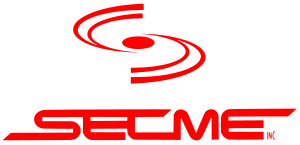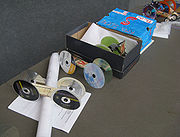
SECME
Encyclopedia

Georgia Institute of Technology
The Georgia Institute of Technology is a public research university in Atlanta, Georgia, in the United States...
. SECME is a strategic alliance to renew and strengthen the professional capacity of K-12 educators, motivate and mentor students, and empower parents so that all students can learn and achieve at higher levels.
History
SECME, Inc., a premier precollege (K-13) alliance, links engineering universities, school systems, and corporate/government investors. Its mission is to increase the pool of historically under-represented,* under-served, and differently-abled students who will be prepared to enter and complete post-secondary studies in science, mathematics, engineering, and technology (under-represented being identified with African American, Hispanic, Mexican American, Native American, Pacific Islander and "differently abled".)SECME was established in 1975 by the Engineering Deans at seven Southeastern universities: Alabama, Florida, Georgia Tech, South Carolina, Tennessee, Tennessee State, and Tuskegee. Today that alliance extends to schools, universities, science and technology based business and industry, and public and private agencies in 17 states (from New York to Arizona), the District of Columbia, and Grand Bahamas.
For its first 22 years, SECME was an acronym for Southeastern Consortium for Minorities in Engineering. In 1997, the name was changed to SECME, Inc. SECME is chartered in the State of Georgia
Georgia (U.S. state)
Georgia is a state located in the southeastern United States. It was established in 1732, the last of the original Thirteen Colonies. The state is named after King George II of Great Britain. Georgia was the fourth state to ratify the United States Constitution, on January 2, 1788...
as a nonprofit, 501(c)(3) corporation. Initially its National Office and administrative home has been in the College of Engineering at the Georgia Institute of Technology in midtown Atlanta.
In creating SECME, the founding Deans acted to address two urgent—and enduring—national challenges: 1) declining engineering enrollments on campuses across the U.S., and 2) growing evidence of shortfalls in technical talent to sustain an economy—and global leadership position—increasingly dependent on technology and innovation as primary engines of growth. Their solution: to tap new talent in two groups then grossly under-represented (at less than 1 percent each) in the engineering profession—namely, minorities and women.
Thus SECME began as a collaborative effort of school districts, engineering universities, business and industry, and government. The noble dream and determined pursuit of the founders was excellence and equity as well as needed change in K-12 education. The school-university partnership was the defining element in the original SECME “framework.” That model is, very intentionally, teacher-centered. But by impacting teachers, it is hoped all students benefit.
You can also find more information on secme.org
Vision
Competitions
Annually, SECME holds one main event, the OlympiadOlympiad
An Olympiad is a period of four years, associated with the Olympic Games of Classical Greece. In the Hellenistic period, beginning with Ephorus, Olympiads were used as calendar epoch....
. Here, a year's worth of study, experimentation and creativity coalesces in a series of county-wide competitions between schools. Depending on the grade level and the district, events can include
- Banners - Students create banners based on the Olympiad’s theme. Banners must contain the school mascot and SECME logo. Each school must have one entry. Schools will parade with their banners at the opening session of the Olympiad.
- Posters - Students create posters based on the Olympiad’s theme. Posters must contain the school mascot and SECME logo.
- Brain Bowl - Students compete against the clock and each other in a contest filled with science questions. Each school may enter one team consisting of four students in the Brain-Bowl competition.
- Bridge Design - Students build balsa wood bridges to pre-determined specifications. Bridges are then tested at the Olympiad. The winner is determined by the most efficient bridge within the specifications. Two individual members from the winning high school team(s) will represent SECME at the International Bridge Contest. Each school may submit one preconstructed bridge in this team event.

- Egg-DropEgg drop competitionThe egg drop contest is an experiment usually performed by college or primary school students. Competitors typically attempt to create a device that can keep a raw chicken egg intact when dropped from a height...
- Students build containers that meet predetermined specifications. At the Olympiad, an uncooked egg is placed in the container and dropped from an initial height of 15 meters. The smallest volume container that protects the egg after being dropped at the final height is deemed the winner. Each middle and senior high school may submit one egg-drop container. The eggs will be supplied at the competition. - Essays - Students write essays at their schools based on the Olympiad’s theme and the best is selected and entered in the District Olympiad. Each school must submit one essay. Essays are due February 15, 2008. Entries received after that date are not eligible for inclusion in the competition (individual event).

- Mousetrap carMousetrap carA mousetrap car is a small vehicle having only one form of motive power being from a mousetrap. Variations include the use of multiple traps, or very big rat traps, for added power....
- Students build cars that are propelled by the spring of a mousetrap. All teams must have a car (constructed and running), a design drawing, and a technical report. A combination of the scores from the race, the report, and the drawing is used to determine the winner. Each school may enter one Mousetrap Car per team. - Computer competitions - Student teams use a web page editor to create a web page. The winner is the team that scores the highest amount of points based on the assigned task within the allocated time. Each school may enter one team consisting of two students.
- Mathematics - Student teams use a variety of strategies to solve mathematics problems using tools such as graphing calculatorGraphing calculatorA graphing calculator typically refers to a class of handheld calculators that are capable of plotting graphs, solving simultaneous equations, and performing numerous other tasks with variables...
s, scientific calculators, rulers, and manipulatives. The winner is determined by the first team to submit the most correct answers within an hour. Each school may enter one team consisting of four students in the mathematics competition. - Water Bottle RocketWater rocketA water rocket is a type of model rocket using water as its reaction mass. The pressure vessel—the engine of the rocket—is usually a used plastic soft drink bottle. The water is forced out by a pressurized gas, typically compressed air...
- Students build a rocket that must meet predetermined specifications. At the Olympiad, rockets will be “fueled” with 355 milliliters of water. The rocket with the greatest combined “hang time” and patch design score will be declared the winner. Each school may enter one rocket built by a team consisting of three students.
Winners from district competitions may continue on to national competitions.

